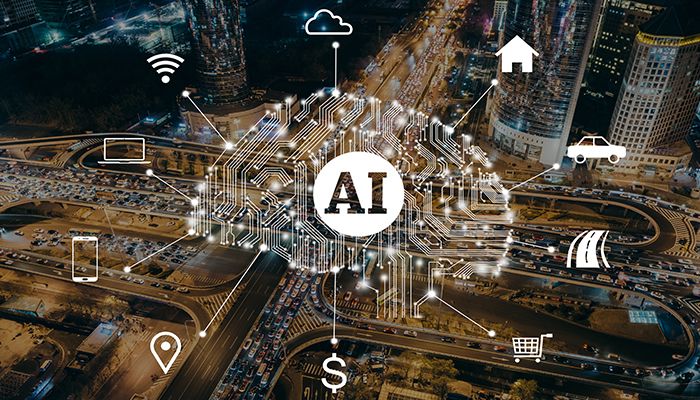Artificial intelligence is machine learning is deep learning, right? Wrong. Instead, think of them as layers of an onion: artificial intelligence is the large, shifting outer peel that can encompass a variety of technologies, applications, and philosophies. Of AI technologies, machine learning is one tool – a statistical tool – that can speed up analysis of large datasets. Deep learning, then, is a small, more intense part of M, that is defined by how that statistical tool’s setup, functionality, and output.
It is incorrect to use the terms ‘deep learning’ and ‘machine learning’ interchangeably. Both models do use statistics to explore data, extract useful meaning or patterns, and make predictions accordingly. Both models are a newer type of AI modeling that contrasts with classic rule-based algorithmic systems.
But, these data modeling paradigms aren’t the same – deep learning can output information that is quicker to use and can seem closer to an AI we imagine. Let’s take a look.
An overview of machine learning
Machine learning is any approach that employs algorithms to sift through data and find patterns. Though a statistical process, it resembles a machine performing a specific mechanical function. The algorithm performs a function, set by the engineer or programmer, and then parses through the data to provide your answer.
As the algorithmic model works its way through a given dataset, the model tends to get better at that function. Perhaps the algorithm has to sift through thousands of pictures of cars zooming through traffic lights to determine which were red lights, warranting a ticket, and which were not. The first few tries, the algorithms won’t get everything right, but over time, it will increase in accuracy, improving well beyond human error.
Some examples of machine learning:
- Spotify or Apple Music serving up new musicians you may like, based on your listening history alongside an aggregate of users with similar interests also like
- A program seeking out malware
- An app that can find favorable financial trades or opportunities
Machine learning is automated, but only to a point. In machine learning, the programmer must still provide guidance, so that if the algorithm spits out a bad or wrong prediction, the programmer must step in and adjust.
Going further with deep learning
Any mention of deep learning will soon be followed by the term “neural networks”, the concept that deep learning is modeled on the human brain’s processing capabilities. This isn’t wholly incorrect, but this explanation tends to overstate the capabilities of deep learning.
Here are the facts: deep learning is a subset of machine learning. Deep learning functions similarly to ML using algorithms and vast amounts of data, but its capabilities go far beyond ML, so its results seem more “intelligent” or sophisticated. Instead of one or two algorithms working at once, as in ML, deep learning relies on a more sophisticated model that layers algorithms. This is known as an artificial neural network, or ANN.
It is this artificial neural network that is inspired, theoretically, by our own brains. Neural networks continually analyze data and update predictions, just as our brains are constantly taking in information and drawing conclusions. Deep learning examples include identifying faces from pictures or videos and recognizing spoken word.
One major difference is that deep learning, unlike ML, will correct itself in the case of a bad prediction, rendering the engineer less necessary. For example, if a lightbulb had deep learning capabilities, it could respond not just to “it’s dark” but to similar phrases like “I can’t see” or “Where’s the light switch?”
Choosing between the two
A quick way to separate machine and deep learning? Machine learning uses algorithms to make decisions based on what it has learned from data. But deep learning uses algorithms – in layers – to create an artificial neural network that makes intelligent decisions on its own. (This doesn’t mean it’s sentient!) Both will parse through your data and improve over time, and both can utilize supervised and unsupervised algorithm models, of which there are many.
While machine learning might feel less sophisticated than deep learning, it shouldn’t immediately get passed over in favor of the mightier deep learning. In fact, machine learning makes sense for smaller data sets and less complicated tasks or automation.
Weakness of machine learning and deep learning
Despite the tech world’s seeming obsession with machine learning and deep learning, experts are wondering whether these AI tools are truly as deep and intelligent as we first anticipated. Even in cutting-edge deep learning environments, successes thus far have been limited to fields that have two vital components: massive amounts of available data and clear, well-defined tasks.
Fields with both, like finance and parts of healthcare, benefit from ML and data learning. But Industries where tasks or data are fuzzy are not reaping these benefits. When it comes to decision making, like predicting an election or writing a persuasive essay, deep learning may be pummeling directly into a technical wall. That’s because teaching common sense is a lot harder than teaching tasks. Common sense – perhaps a shorthand for thinking – is a broader, less tactile process that may produce vague outcomes. How do you teach an algorithm to understand concepts like reasoning, freedom, and wellness?
Programmers are working on AI tools that don’t rely solely on machine or deep learning, rethinking our approach to and definition of “intelligence”. They’re seeking answers to questions that these models can’t comprehend, because they aren’t tasks. For instance, can an application go beyond recognizing words to understanding concepts? Can data be used be efficiently for different types of analyses?
The takeaways are this: deep learning and machine learning are different. They are both tools within the wide world of artificial intelligence. But neither is the silver bullet to achieving AI; investing in other AI approaches is the key to its potential.







